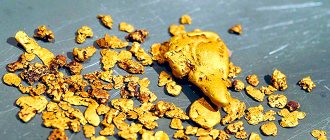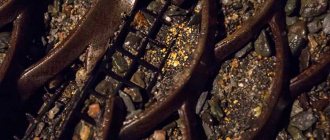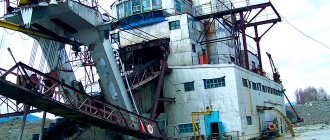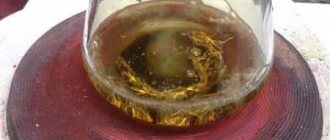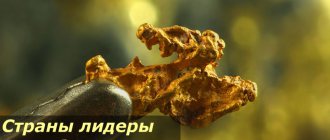Gold in water is not a myth, but a reality that does not require confirmation. Ions of element 79 of D.I. Mendeleev’s table are present in the human body, they are part of plants and, of course, water. The usual liquid is rich in noble metal, it transports gold, carries its particles along the bottom of the river, forming deposits. This water quality is what interests prospectors around the world, who enthusiastically explore rivers and streams.
Finding gold in water
Ion exchange resins - new hopes
Significant research on the extraction of gold from seawater was carried out after the development of technology for extracting gold from solutions using ion exchange resins. Such resins capture gold particles and accumulate them. Today, ion exchange resins are widely used in industry at gold recovery factories, where they are used to extract gold from cyanide solutions. After saturation with gold in special installations, the resin is purified from gold and can be reused, which reduces the cost of the process.
There are several other ways to extract gold using resins. One of them is that the bottoms of ocean ships are covered with resin. While the ship is sailing, the resin collects gold from the water. After some time, the resin from the bottom of the ship can be removed and gold can be extracted from it.
Another idea is to coat special floating catchers in the form of nets or panels with ion-exchange resin. The ship drags a catcher behind it, and when the resin is “saturated” with gold, the catcher is sent for cleaning.
Where and how to look for Au?
Gold is mined from water both in winter and summer. This element can be found using several methods, and cold weather will not stop an experienced prospector. First, you should study the algorithm of actions that will help you extract precious metal from water.
So, what should those who want to find Au do:
- Explore the area, choose a place, chat a little with the locals. Additional information will never be superfluous, for this reason it is worth carefully studying the area, looking at maps and collecting as much information as possible. Conversations with local residents will help establish where Au was found and how long ago it was.
- The gold content in water can be pleasantly surprising and even delightful, but you shouldn’t scuba dive underwater to find it. You can simply examine the rocks, study large stones, take a water sample.
- Using a tray, you need to take a sand sample or examine the bank of a river or stream for the presence of quartz pebbles. Quartz is the main satellite of gold, but you can search not only for it; pyrite and silver can “accompany” Au.
How to get gold and what devices can be used when mining precious metals:
- The water contains Au grains of sand, but they do not float with the flow, but crawl along the bottom. Over the years, grains of sand are compressed and can turn into nuggets and even deposits. A mini-dredge will help you find metal at the bottom. This is a device that works like a vacuum cleaner. The mini dredge sucks up sand and helps locate Au. The machine itself filters, washes and separates gold from impurities and dirt.
- A metal detector is another device that can help you detect precious metals in a river or stream. The device is immersed in water, it can react to gold and detect a deposit at a shallow depth. The coastal area is also being explored using a metal detector.
- Our ancestors used an Au tray when washing. Initially, the devices were made from sheep skins, but later the technology changed. Modern flumes are used for working on mountain rivers and fast-flowing streams. But progress does not stand still and, despite the fact that modern trays are lighter and more convenient, they are used mainly for taking water samples.
The presence of instruments will help speed up the search and increase the chances of success. But this does not mean that expensive equipment is a 100% guarantee of detecting a nugget in the ground or water.
Polymer sponge: a new method for extracting gold from water
An article published in the Journal of the American Chemical Society reported that scientists had found a new method for extracting gold from electronic scrap, waste water, sea water, and virtually anything. A special polymer structure was developed based on iron ions, 1,3,5-benzenetricarboxylate and poly-p-phenylenediamine. The polymer acts like a sponge, absorbing and retaining gold. The sponge is then destroyed and the precious metal is recovered.
Some researchers are enthusiastic and optimistic about this method. Its creators claim that every gram of polymer sponge can absorb 1 g of gold. At the same time, the technology allows you to extract up to 99% of the precious metal from a liquid in just 2 minutes.
Limited tests of the method in laboratory conditions have shown quite attractive results, but the moment when it will actually be possible to extract gold from seas and oceans is still a long way off.
Gold in the sand
Obtaining Au from coastal sand begins with taking it for testing: simply washing it in a tray, studying whether there are grains of the yellow metal.
You can dig up more sand, immerse it in bags and pour water into them. The fact is that sand is much lighter than gold. The noble metal will immediately settle to the bottom and can be seen, but the grains of sand will continue to float in the bag.
Diagram of the possible location of gold in a reservoir
You should filter the water with sand; if there is nothing at hand that can be used as a filter, then the liquid is simply drained. It will go away along with the sand, and Au will remain at the bottom of the bag.
Precious metal is mined from sand exclusively in the summer; in winter, prospectors simply search the coastal zone, examine the stones, but do not wash the sand.
Most often, sand is simply taken for testing, it is lifted from the bottom of the river or dug near the shore. The sample helps determine whether there is Au in the selected location and how much of it there is in that location. If you manage to find more than one or two grains of gold, then you can continue your search. If the amount of yellow metal is negligible, the searchers go to another place.
At what depth can a nugget be found?
- Gold weighing no more than one gram is most often found under a layer of sand of 10–13 cm, and it is not so difficult to get it.
- If you lift the soil 15–30 cm, there is a chance to find a nugget weighing more than 1.5 grams.
- If you dig down to the soil that comes immediately after the sand, you can find a whole piece of noble metal weighing more than 100 grams.
However, Au mining is associated with certain difficulties and there are no guarantees that the “excavations” will end in success. For this reason, it is recommended to study the area and take samples of soil, sand and water before starting the search.
Gold-extracting bacteria
An interesting idea for extracting gold from sea water was proposed by scientists from the University of Heidelberg and the German Cancer Research Center. They believe that special bacteria Delftia acidovorans will help precipitate the precious metal from the liquid. These microorganisms are found only near gold deposits, are adapted to the environment and are able to absorb metal from solutions even with low concentrations. The researchers isolated the necessary genes and introduced them into more common bacteria such as E. coli. A patent application has already been filed.
GPS
In terms of scale, the GPS deposit with resources of 12–15 million tons of ore mass, according to accepted gradations, can be classified as large;
in terms of copper content - very rich; according to the degree of oxidation - mixed; according to the number of associated elements - to complex ones [1]. Thus, based on the above material (Table 1), we believe that the development of the extraction of sulfide ores from GPS deposits in its licensed areas in the central part of the Atlantic Ocean will be of great geopolitical and innovative importance for the Russian Federation (Tables 1 and 5 ). As an analogue, we adopted the project of the Canadian company Nautilus Minerals. As can be seen from the table, the production of polymetals from GPS corresponds to a fairly large-scale mine.
| MSR | Production | |
| 2040 (30) | 2060 (50) | |
| Cu, thousand tons | 150 | 300 |
| Zn, thousand tons | 5 | 100 |
| Au, t | 20 | 24 |
| Ag, t | 90 | 200 |
Table
5. Forecast of production and consumption of metals from GPS in Russian licensed areas
What to expect in the future
The economics of gold extraction depend primarily on its content in seawater. So far, the data on this issue are mixed. The neutron activation method for analyzing the composition of liquids, developed and mastered in recent decades, has made it possible to conduct interesting research. Employees of the research vessel "Mikhail Lomonosov" conducted research in exactly this way.
In the tropical Atlantic Ocean, they analyzed 89 seawater samples for gold, taken at different points and at different depths, even from a depth of more than five kilometers. According to research, the average concentration of precious metal in seawater is significantly higher than previously established. Some samples contained almost a thousand times more gold than could be expected. This confirms the previously stated assumption that the gold content varies very significantly in different places and at different depths.
Heavy metals in water
Natural fresh waters are polluted with heavy metal ions due to anthropogenic human activities. The danger of water pollution with heavy metals lies in the lack of an effective self-purification mechanism. Impurities migrate from one water storage facility to another, settling along the way in the organisms of representatives of aquatic fauna and depositing in plant tissues.
The main sources of water pollution with heavy metals are industrial enterprises, or rather, insufficiently treated wastewater and slag dumps. Harmful substances enter the soil along with sediments filtered through slag. In the case of injection of industrial waste water into mines and pits, there is a significant impact on the quality of groundwater.
Let us remind you that experts do not recommend drilling wells to create a source of drinking water supply in the immediate vicinity of industrial enterprises. Heavy metals dissolved in water migrate with groundwater and end up in aquifers used as water supplies and in surface water bodies.
How gold veins are found
Previously, discoveries of new deposits were often random. A curious man in the street, attracted by the unusual golden color of grains of river sand or the suspicious weight of a stone, picked up an intriguing object, which turned out to be a nugget.
There is a known case where for decades a family in Siberia used a massive black cobblestone as a pressure when pickling cabbage, until a casual acquaintance with experience as a prospector recognized it as a huge nugget.
The first Russian deposit was discovered by the dissenter Erofei Markov, who found a nugget on the road and brought it to the factory office in Yekaterinburg.
Satellites of gold
This element is never found in nature in its pure form. The most common form is sulfides and arsenides. A total of 15 associated minerals are known - silver, rhodium, iridium, platinum, bismuth, copper and others.
Is it worth mining gold from the bottom of the sea?
Question details
The International Seabed Authority (ISSA) this July approved a work plan for Russia to explore polymetallic sulphides, and instructed the ISS Secretary General to sign a contract for the implementation of this work plan in the Mid-Atlantic Ridge (Atlantic Ocean).
According to the Ministry of Natural Resources, geological exploration of the subsoil in the international seabed area is aimed at ensuring a balanced development of the mineral resource base and geopolitical interests of Russia for the long term, in accordance with the maritime doctrine of the Russian Federation for the period until 2021, investments in the next five years are planned in $20-43 million.
We are talking about one of the world's largest undeveloped deposits, where the copper and gold content is five to ten times higher than onshore deposits. The project will be carried out by the state-owned Polar Marine Geological Exploration Expedition and VNIIOkeangeology located in St. Petersburg, which will spend up to $43 million on it in the next five years.
The area that Russia will explore is located in the northern equatorial zone of the Mid-Atlantic Ridge and consists of 100 blocks, each with an area of 100 square kilometers. Sulfide ores there lie at a depth of two to four kilometers.
Six promising objects have been discovered on the site. Forecast resources are 50-70 million tons of dry ore mass. At the same time, the average copper content on land is about 1%, and in deep-sea polymetallic sulfides in the Russian area it can average 2.5-10% (maximum 30%). A ton of ore also contains 4-10 grams of gold (maximum 17 grams per ton).
Similar project
So far, one such project is known - Solwara-1 in Papua New Guinea, owned by Nautilus Minerals. Among shareholders With such resources, only very small volumes of production can be planned. In addition, the report contains a cost calculation, but no profitability calculation. In some ways, this is similar to gold mining from Spanish galleons,” Yakubchuk noted.
Nautilus materials note that capital costs for Solwara-1 are estimated at $383 million. The project area is 15 thousand square kilometers (depth - 1.6 kilometers).
It is planned to extract 1.2-1.8 million tons of ore annually.
Nautilus plans to begin ore mining in 2013-2014. This will be the world's first developed deep-sea gold-copper deposit. The company spent $12.4 million on geological exploration in 2010, and $9.9 million in 2009. But this does not take into account the equipment. Nautilus spends $25 million a year on exploration vessel charters alone. Renting one unmanned deep-sea vehicle costs $3,000 per day. At the production stage, costs are several times higher - just one vessel for the production of concentrate will cost Nautilus $167 million, the riser and lifting system - $116 million, drills and reservoir - $84 million.
Existing experience
Today, diamond mining companies are actively engaged in mining from the seabed, in particular, the world's largest diamond producer De Beers (controls about 40% of the rough diamond market) extracts almost all of its products from the seabed. Mining is difficult, but highly profitable.
In addition, the British company Ridgeback Global Resources is engaged in the search and development of diamond and gold deposits on the shelf of the South African coast. In particular, on the shelf of the western coast of South Africa (in the area of the Groen River), an enterprise has been organized at the Panda underwater site. Potential diamond deposits are estimated at about $14.1 billion. One vessel is already producing; funds are being invested in the acquisition of three additional vessels. The cost of one vessel is $1.5 million, operating costs are $30 thousand per day. It is planned to produce 110.4 thousand carats of diamonds per year at the site at an average market price of $850 per carat. Number of employees: 100 people.
Ridgeback notes that thanks to the rapid development of deep-sea technology, it is now possible to mine from depths of up to 200 meters and carry out selection directly on board. De Beers operates five of these dedicated vessels, as well as one research vessel.
In the nineties, the beginning of the era of major technical solutions in this area, a variety of “deep-sea mining” methods were tested. A leap forward with a cost-effective “vertical” solution was finally made by the German company Aker Wirth, which is part of the international concern AkerSolutions. This new method ensured an increase in production by several hundred percent at once.
The method is based on the “air lift” method: a drill bit (“drill”) with a diameter of 6.5 meters is lowered from the derrick of a drilling ship along a drill shaft, a hole in the middle of the ship’s hull, to the seabed and rotates along the drill string. A drill weighing 60-65 tons rotates approximately 12-25 times per minute and loosens the diamond-containing rock layer with special “cutters” rotating inside the drill bit. The stones, which themselves weigh several tons, are gradually crushed. Through a column with an internal diameter of 60 centimeters, using compressed air, a mixture of water and rock falls on board the ship for further processing.
Other opinions
As for the prospects for mining polymetals at such great depths as in the Atlantic Ocean, the profitability of such projects is still almost impossible to assess, notes Gleb Moralev, chief geologist of NordGold (the gold mining subsidiary of Severstal).
“Once upon a time, offshore oil production seemed unrealistic, but in a historically short time it was offshore production that made Norway a leading oil power. Therefore, from a fundamental point of view, sooner or later it will be necessary to begin the development of deposits of metallic minerals at great depths. If reserves and grades turn out to be large, then mining will be profitable at great depths,” he said.
“I have no doubt that many times more funds will be required than stated. In addition, it will be necessary to develop a mass of technical means for conducting geological exploration and development,” Moralev believes.
In turn, Rye, Man & Gor analyst Andrei Tretelnikov believes that the economics of such a project should be good. “This is a long-term project, so Russia is doing everything in advance to score a place and try to get ahead of China. The project is also economically profitable in terms of high grades,” he said.
Commenting on the low costs of geological exploration during the first five years, Tretelnikov suggested that these are preliminary costs necessary to determine the boundaries of the future field.
According to Oleg Petropavlovsky, an analyst at the BCS financial group, the project as a whole is unique. “So far I have not heard, either in the world or in Russia, that any of these projects have yet received practical implementation. The waters of the world’s oceans contain significant reserves of metals, including rare earths, and at current prices for gold, for example, one can expect it to be profitable; the whole question is whether there are sufficient technologies for the development of such deposits,” says the expert.
What happens next to the mined gold?
The mined metal still contains impurities. They are removed using refining. At the initial stage, the raw material is cleared of iron impurities and treated with nitric acid, while gold precipitates. Further processing is carried out using hydrochloric and nitric acids and evaporation. This method allows you to achieve a purity of the substance at the level of 99.95%.
To achieve maximum metal purity, electrochemical refining is used: hydrochloric acid in solution serves as an electrolyte, the anode is the raw material for purification, and the cathode is a gold rod of the highest standard.
Profitability and laws
Gold mining on an industrial scale can only be carried out if the deposit is profitable - at least 3 g per ton of ore. If a mine cannot provide this level of metal production, it is recognized as unprofitable, and work on it is stopped.
Until 2021, individuals were prohibited from mining metal even in depleted deposits. Violation of the law entailed punishment including criminal liability. However, the law has been revised, and now gold mining can be carried out by a private individual who has registered an individual entrepreneur.
Extraction of valuable metal is subject to licensing by the Rosnedra organization. Before obtaining permission, the applicant will have to win this right at an auction, and the cost of such a license amounts to billions of rubles if we are talking about promising deposits.
Without obtaining a special permit, you can mine precious metal by concluding a contract with a gold mining organization to carry out work on its territory.
Profit today and prospects for the future
Gold is a measure of the well-being of entire states. As an investment object, it shows a steady increase in value year after year, which makes it an excellent source of investment. According to experts, this trend will continue in the coming years.

